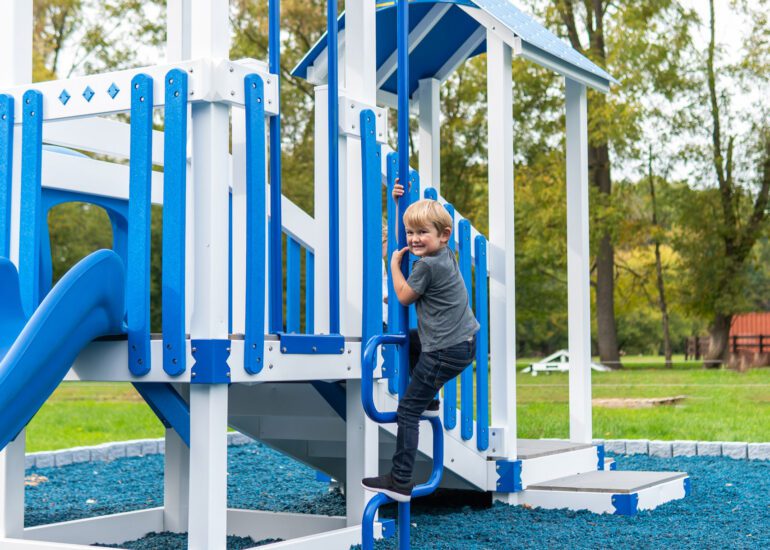
Playground Equipment for Preschools: What to Research
Are you looking for playground equipment for preschools?
While I never taught preschool, I interacted with the teachers and students; let me tell you something, those children have some energy! From the moment those students entered to the second they left, those preschool students were a bundle of talking, wiggling, laughing, and all forms of various and sundry noises, motions, and vibrations.
Hats off to you, mighty preschool teachers; you deserve peace and quiet with a warm blanket curled up before a fire.
This is not an “I will try to convince you to buy a playground” post. The need is pretty obvious, in my opinion. If you are unsure, ask the teacher, and they will let you know.
Instead, this post is about what you need to consider before purchasing playground equipment for preschool. While every state, county, and city has its own rules and regulations, this list is meant to be a starting point for you, not a replacement for your research. A compass may point north, but you still need a detailed map. Let this serve as your compass.
Here are 5 Items To Be Considered for Playground Equipment for Preschools.
1) Safety Standards
The first and probably one of the most important parts of your research is discovering whether your playground has to meet ASTM standards or not. This is found by but not limited to looking up what your liability insurance requires or what your local ordinances for preschools require.
I cannot pretend to speak for every preschool everywhere since your type, affiliation, and structure can dramatically impact what type of playground you need. Please be thorough and not skim on this research.
2) Accessibility Rules
The Americans with Disabilities Act (ADA) has rules and guidelines for inclusive playgrounds. Inclusive playgrounds are on the rise, which is amazing. Even if you do not currently have any children with disabilities enrolled in your school, local ordinances, state ordinances, or guidelines may require your playground to be handicap accessible.
Don’t forget about the accessibility of the playground surface as well. Wood mulch and rubber mulch offer poor accessibility to wheelchairs, while poured-in-place rubber flooring is amazing.
3) State and Local Laws
Each state or local government may have laws directly affecting your playground’s design. Everything from fencing, proper signage, or what type and how much surfacing you need.
Don’t try to pull a fast one on your local government. Do your research, obey the rules, and everyone will be much happier in the end.
4) Licensing Requirements
This one will, unfortunately, be vague. I am writing this in the town of Parkesburg, which is in Chester County in the state of Pennsylvania. The city could have its own unique licensing requirements, the county could have separate ones, and the state could go as well. This is honestly a catch-all and reminder for you to do your own research.
5) Maintenance Requirements
Your local government, insurance, and playground manufacturer may have maintenance requirements listed to keep the set in good standing. For example, properly maintaining the mulch depth in the playground area is critical for safe play.
Your preschool should have a maintenance plan in place and a person in that role. It should have weekly inspections that are documented.
Ok, that all sounds confusing and intimidating. The fact that all of our commercial playgrounds were designed by certified playground safety inspectors and built to ASTM standards should take some of the worries out of it for you.
When we at King Swings floated the idea of launching a commercial playground line, our big goal was to do it right. To make playgrounds that were fun but also geared around that ASTM inspection. We want you to purchase confidently, knowing your set will pass with flying colors.
The Pioneer: Perfect Playground for Preschool
If you are a preschool, the Pioneer Playground is a great option. The lower deck heights provide peace of mind for the parents, but it is still packed full of fun. The towers are spacious and easily accessible for adults if a teacher needs to intervene on the playground.
The Pioneer Playground includes a 3’ super spiral slide, a 3’ avalanche slide, our tree climber, and a finger maze toy panel. The first tower is 1’ tall, while the tallest tower is 3’. Each tower is 4’x4’.
You can find the Pioneer Playground here, as well as all the rest of the information you need. Be sure to watch the video and download any of the information sheets you need.
If you need to add swings to the Pioneer Playground, we can add swing beams to your set. Our swing beams are free-standing structures that can be placed close to the Pioneer Playground or in a separate area. You can check out pre-made playground packages with the Pioneer here.
Having staff outside to monitor play is very important. You can provide them with poly benches that match your playground with our playground accessories. And don’t forget about trash cans! Keep the trash where it belongs instead of billowing about your playground.
If you have any questions about our commercial playgrounds, Katie and Blake would love to help you out. You can get in touch with them by calling our office or shooting them an email. They also can be reached on our Socials!


